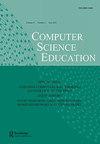Editorial
IF 2.2
Q1 EDUCATION & EDUCATIONAL RESEARCH
引用次数: 0
Abstract
We are very excited to introduce this issue of Computer Science Education. Readers will quickly identify a common theme of computational thinking across these papers, but the papers have more in common than just that. As a group, these papers challenge readers to consider for whom is computing, how do we support a more inclusive and equitable environment for the full range of learners, and what computational tools and pedagogical scaffolds do our teachers need to help learners do so? We hope that you will enjoy this engaging issue. The first paper, by Worsley and Bar-El, explores obstacles to engagement with makerspaces and “making” for learners with disabilities. They describe the design and implementation of a university course on inclusive making, followed by application of qualitative methods to explore why students choose to enroll in the interdisciplinary course and what they learn as a result about accessibility in this context. Data presented from three course offerings suggests that the nature of the course attracts a diverse group of students, and that their own identity beliefs play an important role in self-selecting into the course. Their analysis of course projects shows the variety of ways students applied their knowledge of course content to envision a more inclusive environment for making. This work provides an insightful framework for others seeking to expose students to elements of inclusive design. Prado, Jacob, and Warschauer continue our consideration of inclusive computing education by turning our attention to a comparative study of computational thinking in two primary school classrooms: one that includes students with and without disabilities, and one that includes students who have and have not been identified as part of a gifted and talented program. Their rich qualitative analysis underscores the importance of differentiated and scaffolded instructional strategies for teaching computational thinking to diverse groups of students, and it reminds us that the strategies needed may look different for different populations. In progressing towards a future of CSforAll, this paper challenges us to think broadly about how teachers adapt to meet all students where they are. The third paper in this issue, by Rich, Franklin, Strickland, Isaacs, and Eatinger, also focuses on how primary school students develop their understanding of computational thinking. However, their work explores the trajectory of mastering the concept of variables within integrated mathematics and computing activities. Their literature-driven analysis identified eight distinct goals and four progressively sophisticated levels of student thinking with respect to variables. The authors then instantiate this progression through a concrete set of activities to conceptually demonstrate its utility in guiding instructional design and sequencing of activities. Elaborating the relationships and dependencies of knowledge, skills, and abilities within computing at age-appropriate levels, as the authors have done in this paper, is an important contribution in establishing evidence-based pedagogies for computing. COMPUTER SCIENCE EDUCATION 2022, VOL. 32, NO. 2, 153–154 https://doi.org/10.1080/08993408.2022.2085908社论
我们很高兴能介绍这期《计算机科学教育》。读者会很快在这些论文中找到计算思维的共同主题,但这些论文的共同点不止于此。作为一个群体,这些论文要求读者考虑谁是计算,我们如何为所有学习者提供一个更具包容性和公平的环境,以及我们的老师需要什么计算工具和教学支架来帮助学习者做到这一点?我们希望你会喜欢这个引人入胜的问题。Worsley和Bar-El的第一篇论文探讨了参与makerspaces和残疾学习者“制作”的障碍。他们描述了一门关于包容性制作的大学课程的设计和实施,然后应用定性方法来探索学生为什么选择参加跨学科课程,以及他们在这种情况下学习到了什么。三门课程的数据表明,课程的性质吸引了不同的学生群体,他们自己的身份信念在自主选择课程中发挥着重要作用。他们对课程项目的分析表明,学生们运用课程内容知识来设想一个更具包容性的制作环境的方式多种多样。这项工作为其他寻求让学生接触包容性设计元素的人提供了一个富有洞察力的框架。Prado、Jacob和Warschauer继续我们对包容性计算教育的考虑,将我们的注意力转向对两个小学教室计算思维的比较研究:一个包括有残疾和没有残疾的学生,另一个包括已经和没有被确定为天才和天才项目一部分的学生。他们丰富的定性分析强调了差异化和脚手架式教学策略对向不同群体的学生教授计算思维的重要性,并提醒我们,不同人群所需的策略可能不同。在迈向CSforAll的未来的过程中,本文挑战我们广泛思考教师如何适应所有学生的需求。本期的第三篇论文由Rich、Franklin、Strickland、Isaacs和Eatinger撰写,也关注小学生如何发展他们对计算思维的理解。然而,他们的工作探索了在综合数学和计算活动中掌握变量概念的轨迹。他们的文献驱动分析确定了八个不同的目标和四个逐渐复杂的学生对变量的思考水平。然后,作者通过一组具体的活动来实例化这种进展,从概念上证明它在指导教学设计和活动顺序方面的实用性。正如作者在本文中所做的那样,在适龄水平上详细阐述计算中知识、技能和能力的关系和依赖性,是对建立基于证据的计算教学法的重要贡献。计算机科学教育2022,第32卷,第2期,153-154https://doi.org/10.1080/08993408.2022.2085908
本文章由计算机程序翻译,如有差异,请以英文原文为准。
求助全文
约1分钟内获得全文
求助全文
来源期刊

Computer Science Education
EDUCATION & EDUCATIONAL RESEARCH-
CiteScore
6.90
自引率
3.70%
发文量
23
期刊介绍:
Computer Science Education publishes high-quality papers with a specific focus on teaching and learning within the computing discipline. The journal seeks novel contributions that are accessible and of interest to researchers and practitioners alike. We invite work with learners of all ages and across both classroom and out-of-classroom learning contexts.
 求助内容:
求助内容: 应助结果提醒方式:
应助结果提醒方式:


